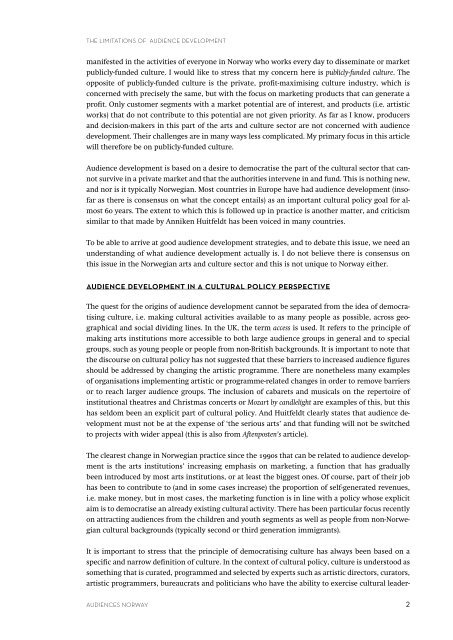the limitations of audience development - Arts And Audiences
the limitations of audience development - Arts And Audiences
the limitations of audience development - Arts And Audiences
You also want an ePaper? Increase the reach of your titles
YUMPU automatically turns print PDFs into web optimized ePapers that Google loves.
The limiTaTions <strong>of</strong> <strong>audience</strong> developmenT<br />
manifested in <strong>the</strong> activities <strong>of</strong> everyone in Norway who works every day to disseminate or market<br />
publicly-funded culture. I would like to stress that my concern here is publicly-funded culture. The<br />
opposite <strong>of</strong> publicly-funded culture is <strong>the</strong> private, pr<strong>of</strong>it-maximising culture industry, which is<br />
concerned with precisely <strong>the</strong> same, but with <strong>the</strong> focus on marketing products that can generate a<br />
pr<strong>of</strong>it. Only customer segments with a market potential are <strong>of</strong> interest, and products (i.e. artistic<br />
works) that do not contribute to this potential are not given priority. As far as I know, producers<br />
and decision-makers in this part <strong>of</strong> <strong>the</strong> arts and culture sector are not concerned with <strong>audience</strong><br />
<strong>development</strong>. Their challenges are in many ways less complicated. My primary focus in this article<br />
will <strong>the</strong>refore be on publicly-funded culture.<br />
Audience <strong>development</strong> is based on a desire to democratise <strong>the</strong> part <strong>of</strong> <strong>the</strong> cultural sector that cannot<br />
survive in a private market and that <strong>the</strong> authorities intervene in and fund. This is nothing new,<br />
and nor is it typically Norwegian. Most countries in Europe have had <strong>audience</strong> <strong>development</strong> (ins<strong>of</strong>ar<br />
as <strong>the</strong>re is consensus on what <strong>the</strong> concept entails) as an important cultural policy goal for almost<br />
60 years. The extent to which this is followed up in practice is ano<strong>the</strong>r matter, and criticism<br />
similar to that made by Anniken Huitfeldt has been voiced in many countries.<br />
To be able to arrive at good <strong>audience</strong> <strong>development</strong> strategies, and to debate this issue, we need an<br />
understanding <strong>of</strong> what <strong>audience</strong> <strong>development</strong> actually is. I do not believe <strong>the</strong>re is consensus on<br />
this issue in <strong>the</strong> Norwegian arts and culture sector and this is not unique to Norway ei<strong>the</strong>r.<br />
<strong>audience</strong> <strong>development</strong> in a cultural policy perspective<br />
The quest for <strong>the</strong> origins <strong>of</strong> <strong>audience</strong> <strong>development</strong> cannot be separated from <strong>the</strong> idea <strong>of</strong> democratising<br />
culture, i.e. making cultural activities available to as many people as possible, across geographical<br />
and social dividing lines. In <strong>the</strong> UK, <strong>the</strong> term access is used. It refers to <strong>the</strong> principle <strong>of</strong><br />
making arts institutions more accessible to both large <strong>audience</strong> groups in general and to special<br />
groups, such as young people or people from non-British backgrounds. It is important to note that<br />
<strong>the</strong> discourse on cultural policy has not suggested that <strong>the</strong>se barriers to increased <strong>audience</strong> figures<br />
should be addressed by changing <strong>the</strong> artistic programme. There are none<strong>the</strong>less many examples<br />
<strong>of</strong> organisations implementing artistic or programme-related changes in order to remove barriers<br />
or to reach larger <strong>audience</strong> groups. The inclusion <strong>of</strong> cabarets and musicals on <strong>the</strong> repertoire <strong>of</strong><br />
institutional <strong>the</strong>atres and Christmas concerts or Mozart by candlelight are examples <strong>of</strong> this, but this<br />
has seldom been an explicit part <strong>of</strong> cultural policy. <strong>And</strong> Huitfeldt clearly states that <strong>audience</strong> <strong>development</strong><br />
must not be at <strong>the</strong> expense <strong>of</strong> ‘<strong>the</strong> serious arts’ and that funding will not be switched<br />
to projects with wider appeal (this is also from Aftenposten’s article).<br />
The clearest change in Norwegian practice since <strong>the</strong> 1990s that can be related to <strong>audience</strong> <strong>development</strong><br />
is <strong>the</strong> arts institutions’ increasing emphasis on marketing, a function that has gradually<br />
been introduced by most arts institutions, or at least <strong>the</strong> biggest ones. Of course, part <strong>of</strong> <strong>the</strong>ir job<br />
has been to contribute to (and in some cases increase) <strong>the</strong> proportion <strong>of</strong> self-generated revenues,<br />
i.e. make money, but in most cases, <strong>the</strong> marketing function is in line with a policy whose explicit<br />
aim is to democratise an already existing cultural activity. There has been particular focus recently<br />
on attracting <strong>audience</strong>s from <strong>the</strong> children and youth segments as well as people from non-Norwegian<br />
cultural backgrounds (typically second or third generation immigrants).<br />
It is important to stress that <strong>the</strong> principle <strong>of</strong> democratising culture has always been based on a<br />
specific and narrow definition <strong>of</strong> culture. In <strong>the</strong> context <strong>of</strong> cultural policy, culture is understood as<br />
something that is curated, programmed and selected by experts such as artistic directors, curators,<br />
artistic programmers, bureaucrats and politicians who have <strong>the</strong> ability to exercise cultural leader-<br />
<strong>audience</strong>s norway<br />
2


